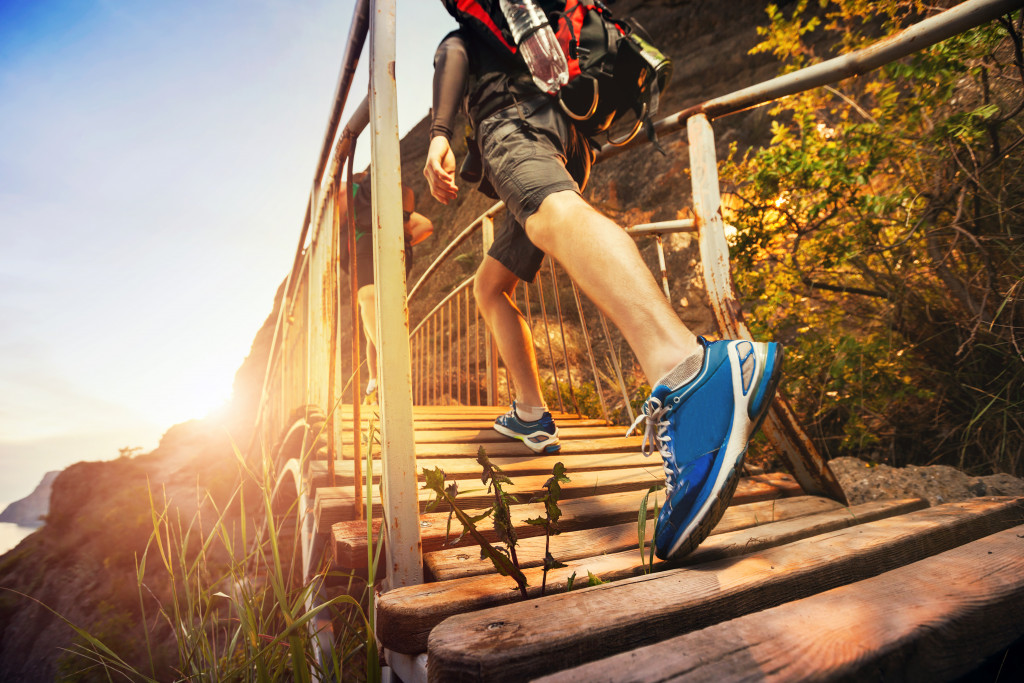Is it perhaps your first time to go hiking after the pandemic? Here is a definitive guide on what to prepare so you can ensure your safety:
Visuals
One of the indispensable elements of safety is visibility. You also have to remember that, unless you’ve been to the same hiking trail before, you are practically encroaching unfamiliar territory. And so, you want to bring the unpredictability of the events that could transpire to a minimum.
With this, you should not disregard the importance of including eye protection in your hiking essentials. If you’re leaving for the trip when the sun is out, you want to bring polarized and UV ray-blocking sunglasses that will lessen the sun’s glare and, therefore, give you a good view of the trail path and any obstructions ahead. Polarized types of glasses will also help you see through puddled surfaces, therefore, better averting harmful animals or objects.
Base your eyewear choice on how frequently you plan to hike or engage in other high-intensity activities. If you plan on maintaining a hiking streak in the immediate future, it is best to invest in a durable pair now that is made of polycarbonate instead of easy-scratch plastic lenses and arms and nose pieces that grip tightly against your head. When hiking on cold winter or windy days when you can expect a lot of flying debris, it is best to don a pair of goggles.
In the event, you will hike on a gloomy day or commence it late in the afternoon, anticipate that visibility could be an issue. And so, you should bring monocles or a binocular set integrated with night-vision features.
Protective Gear
Your eyes aren’t the only senses you need to undividedly engage during a hike. You need to sense sources of imminent danger like falling tree branches, insects, or animals that have venomous bites, or fire, by hearing or smelling them, and so it is only right to put on protective covering around your head.
A full-face cover, visor, hiking hat, or headband which you can pull down to your neck from time to time are viable options that also protect you from the sun’s harmful rays. The same goes for the entire body which can be highly susceptible to insect bites and scratches from contact with weeds, and so you have to wear clothing specifically designed for hiking made of breathable and sweat-wicking materials like polyester and nylon. Depending on how cold it is out, you might have to prepare to layer on an insulating jacket.
Of course, you also have to acknowledge the probability that you will stumble along the way because not necessarily all trails are paved for pedestrian use. That said, you should wear elbow and knee pads. Just in case you get separated from your hiking team, a whistle would be great to use for them to easily locate you.
More importantly, you should bring a hiking stick. You could purchase collapsible types of these sticks which you can conveniently pull out as needed and pack into your bag when no longer needed. This will help improve your traction especially on steeper planes and ward off possibly approaching wild animals.
Rehydration

You can bring a water tumbler for relatively short hikes. A water bladder is the more practical water storage for longer hikes, on the other hand. Depending on the brand or model, a water bladder could pack a maximum of over 20 liters, which makes for unlimited replenishment during the trip. What makes water bladders the better option for rehydrating is that it comes with a bendable straw which you can simply draw out from its body and take water from while you are in transit.
Hydration multipliers are your best bet for more challenging hikes when you cannot be bothered to take a break. With a stick of this powdered formula that you can dissolve in a bottle of water, you can obtain all the electrolytes enough to last you for the rest of the hike. Cucumbers are another rich source of water that is easy to pack, in case you wanted a healthier and natural alternative.
Pain Relief
Just when you’re about to accomplish the entire trail, your body may signal its exhaustion or over-exertion through pain. Before the pain inhibits you to go on and ultimately keeps you from heading back downtown, make sure to apply for temporary pain relief on affected areas. You can use a topical pain spray, gel, or oil.
You can alleviate painful joints by wrapping them with a bandage just tight enough so that blood can still circulate in the area. A flexible back brace, on the other hand, can help alleviate a strained back.
Yourself
You can better prepare yourself by recalling previous injurious events. If you have not gotten treatment for them yet, engaging in an intensive activity like hiking could trigger the pain and the other symptoms of these injuries to relapse.
And so, it is best to have your doctor or a trusted orthopedic expert check the problematic area and recommend appropriate medical intervention. One treatment method that is recently gaining popularity is the Class IV deep tissue laser therapy because it is non-invasive, therefore, less painful to undergo and quicker to heal from.
You could have packed everything you need, but nothing beats preparing your body for this physically intensive endeavor. Professional hikers would advise, especially those who do not regularly exercise, to engage in moderate exercise a week ahead of the scheduled hiking trip. If this is ticked off your list, you are good to go.

